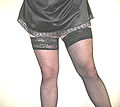Transvestic fetishism: Difference between revisions
Unsourced. |
|||
| Line 12: | Line 12: | ||
# This causes clinically significant distress or impairment, whether socially, at work, or elsewhere. |
# This causes clinically significant distress or impairment, whether socially, at work, or elsewhere. |
||
Thus, transvestic fetishism is not diagnosed unless it causes significant problems for the person concerned. |
Thus, transvestic fetishism is not diagnosed unless it causes significant problems for the person concerned. |
||
== Possible causes of transvestic fetishism == |
|||
The main reason why a fetishist man get aroused by women's clothing is mainly due to the material they are made, the softer to the touch, the greater the stimulation. In fact, is the stimulation of the erogenous zones causing sexual arousal in the fetishist man. |
|||
If a man wears woman's clothing , such as lycra stockings, made of a smooth and soft material, to the contact with the corresponding erogenous zones, including the buttocks, feet and legs, will cause sexual arousal in the man due to stimulation of these. |
|||
== Transvestic fetishism treatment == |
|||
The transvestic fetishism treatment consists of not wearing women´s clothing, and stay away from them and from the sight of men who wear them. |
|||
==Gallery== |
==Gallery== |
||
Revision as of 04:43, 10 January 2013
| Cross-dressing |
|---|
Transvestic fetishism is a psychiatric diagnosis applied to those who are thought to have an excessive sexual or erotic interest in cross-dressing; this interest is often expressed in autoerotic behavior. It differs from cross-dressing for entertainment or other purposes that do not involve sexual arousal, and is categorized as a paraphilia in the Diagnostic and Statistical Manual of the American Psychiatric Association. (Sexual arousal in response to donning sex-typical clothing is homeovestism.)
Description
Transvestic fetishism refers specifically to cross-dressing; sexual arousal in response to individual garments is fetishism.[1] A person who is diagnosed with Gender Identity Disorder should not receive a diagnosis of Tranvestic Fetishism,[1] although sometimes those with this diagnosis do go on to develop gender dysphoria, and then meet the criteria for a diagnosis of Gender Identity Disorder.[1] Most men who have transvestic fetishism do not have a problem with their assigned sex.
Some male transvestic fetishists collect women's clothing, e.g. nightgowns, babydolls, bridal gowns, slips, brassieres, and other types of nightwear, lingerie, stockings, pantyhose, shoes, and boots, items of a distinct feminine look and feel. They may dress in these feminine garments and take photographs of themselves while living out their fantasies. According to the DSM-IV, this fetishism has been described only in heterosexual men.
There are two key criteria before a psychiatric diagnosis of "transvestic fetishism" is made:[1]
- Recurrent, intense sexually arousing fantasies, urges, or behaviour, involving cross-dressing.
- This causes clinically significant distress or impairment, whether socially, at work, or elsewhere.
Thus, transvestic fetishism is not diagnosed unless it causes significant problems for the person concerned.
Gallery
-
A sissy crossdresser in feminine office wear
-
An example of transvestic fetishism
-
Some men find the sheer fabric of stockings highly erotic
-
Transvestic fetishism involving a half slip and stockings
See also
References
- Sources
- Laws, Richard D.; O'Donohue, William T., eds. (2008). Sexual Deviance: Theory, Assessment, and Treatment (2 ed.). New York: Guilford Press. ISBN 978-1-59385-605-2.
{{cite book}}:|access-date=requires|url=(help)
- Notes



